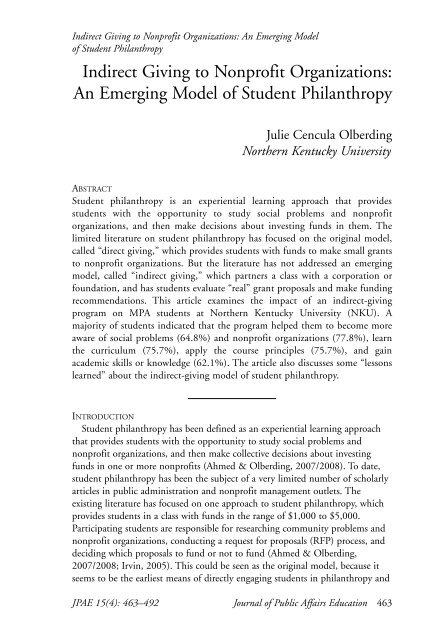JOURNAL OF PUBLIC AFFAIRS EDUCATION - National ...
JOURNAL OF PUBLIC AFFAIRS EDUCATION - National ...
JOURNAL OF PUBLIC AFFAIRS EDUCATION - National ...
Create successful ePaper yourself
Turn your PDF publications into a flip-book with our unique Google optimized e-Paper software.
Indirect Giving to Nonprofit Organizations: An Emerging Model<br />
of Student Philanthropy<br />
Indirect Giving to Nonprofit Organizations:<br />
An Emerging Model of Student Philanthropy<br />
Julie Cencula Olberding<br />
Northern Kentucky University<br />
ABSTRACT<br />
Student philanthropy is an experiential learning approach that provides<br />
students with the opportunity to study social problems and nonprofit<br />
organizations, and then make decisions about investing funds in them. The<br />
limited literature on student philanthropy has focused on the original model,<br />
called “direct giving,” which provides students with funds to make small grants<br />
to nonprofit organizations. But the literature has not addressed an emerging<br />
model, called “indirect giving,” which partners a class with a corporation or<br />
foundation, and has students evaluate “real” grant proposals and make funding<br />
recommendations. This article examines the impact of an indirect-giving<br />
program on MPA students at Northern Kentucky University (NKU). A<br />
majority of students indicated that the program helped them to become more<br />
aware of social problems (64.8%) and nonprofit organizations (77.8%), learn<br />
the curriculum (75.7%), apply the course principles (75.7%), and gain<br />
academic skills or knowledge (62.1%). The article also discusses some “lessons<br />
learned” about the indirect-giving model of student philanthropy.<br />
INTRODUCTION<br />
Student philanthropy has been defined as an experiential learning approach<br />
that provides students with the opportunity to study social problems and<br />
nonprofit organizations, and then make collective decisions about investing<br />
funds in one or more nonprofits (Ahmed & Olberding, 2007/2008). To date,<br />
student philanthropy has been the subject of a very limited number of scholarly<br />
articles in public administration and nonprofit management outlets. The<br />
existing literature has focused on one approach to student philanthropy, which<br />
provides students in a class with funds in the range of $1,000 to $5,000.<br />
Participating students are responsible for researching community problems and<br />
nonprofit organizations, conducting a request for proposals (RFP) process, and<br />
deciding which proposals to fund or not to fund (Ahmed & Olberding,<br />
2007/2008; Irvin, 2005). This could be seen as the original model, because it<br />
seems to be the earliest means of directly engaging students in philanthropy and<br />
JPAE 15(4): 463–492 Journal of Public Affairs Education 463

















